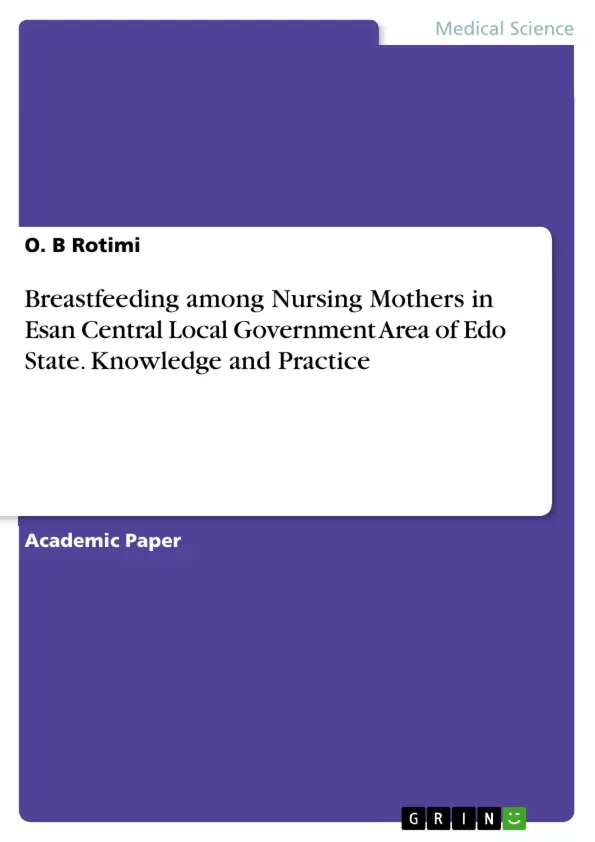The study was undertaken to assess the knowledge and practice of breast feeding among nursing these nursing mothers in Esan central local government area of Edo State. The sample was one hundred thirty nursing mothers attending immunization in all the Primary Health Care Centres in Esan Central Local Government in Edo State of Nigeria that were selected from the population through multistage method of sampling.
The female nursing mothers were provided with yes or no for rating of the knowledge and practice of breast feeding among nursing these nursing mothers. The data were analyzed using frequent count and simple percentage for research question while Pearson Product Moment Correlation Coefficient were used to test the hypnoses to determine the relationship between knowledge and practice of breast feeding among nursing mothers.
Inhaltsverzeichnis (Table of Contents)
- Abstract
- Introduction
- Concept of Breastfeeding
- Methods
- Findings
- Discussion of findings
- Conclusion
- Recommendations
- References
Zielsetzung und Themenschwerpunkte (Objectives and Key Themes)
The main objective of this study was to assess the knowledge and practice of breastfeeding among nursing mothers in Esan Central Local Government Area of Edo State, Nigeria. The study aimed to determine the relationship between knowledge and practice of breastfeeding.
- Knowledge of breastfeeding practices among nursing mothers.
- The practice of breastfeeding among nursing mothers.
- The relationship between knowledge and practice of breastfeeding.
- Benefits of breastfeeding for mothers and infants.
- Factors influencing breastfeeding practices.
Zusammenfassung der Kapitel (Chapter Summaries)
Abstract: This study investigated the knowledge and practice of breastfeeding among 130 nursing mothers in Esan Central Local Government Area, Edo State, Nigeria. Using a multistage sampling method, the study employed a yes/no rating system to assess knowledge and practice. Data analysis involved frequency counts, simple percentages, and Pearson's Product Moment Correlation Coefficient to determine the relationship between knowledge and practice. Findings revealed a significant relationship between knowledge and practice, with high knowledge levels but low breastfeeding practice rates among the mothers.
Introduction: This chapter establishes the importance of breastfeeding as the optimal source of nutrition for newborns, highlighting the unique composition of breast milk and its protective benefits against infectious diseases. It contrasts breast milk with infant formula, emphasizing the superior digestibility and immune-boosting properties of breast milk. The chapter emphasizes the World Health Organization (WHO) and UNICEF recommendations for exclusive breastfeeding for the first six months and continued breastfeeding until two years of age. The introduction also touches upon the benefits of breastfeeding for both the mother and child, and the role of education and support in improving breastfeeding rates.
Schlüsselwörter (Keywords)
Breastfeeding, knowledge, practice, nursing mothers, infant nutrition, immune system, exclusive breastfeeding, World Health Organization (WHO), UNICEF, Edo State, Nigeria.
Frequently Asked Questions: A Study on Breastfeeding Knowledge and Practice
What is the main objective of this study?
The primary goal was to evaluate the knowledge and practice of breastfeeding among nursing mothers in Esan Central Local Government Area, Edo State, Nigeria, and to determine the relationship between these two factors.
What key themes are explored in this study?
The study explores the knowledge of breastfeeding practices among nursing mothers, their actual breastfeeding practices, the correlation between knowledge and practice, the benefits of breastfeeding for mothers and infants, and the factors influencing breastfeeding practices.
What methodology did the study use?
A multistage sampling method was employed, involving 130 nursing mothers. A yes/no rating system assessed knowledge and practice. Data analysis included frequency counts, simple percentages, and Pearson's Product Moment Correlation Coefficient to analyze the relationship between knowledge and practice.
What were the key findings of the study?
The study found a significant relationship between knowledge and practice of breastfeeding. While mothers demonstrated high levels of knowledge, the actual practice of breastfeeding was lower than expected.
What are the main topics covered in the different chapters?
The study includes an abstract summarizing the research, an introduction establishing the importance of breastfeeding, a chapter dedicated to the concept of breastfeeding, a methodology section detailing the research approach, a findings section presenting the results, a discussion interpreting the findings, a conclusion summarizing the key insights, recommendations for future actions, and a list of references.
What are the benefits of breastfeeding discussed in the study?
The study highlights the superior nutritional value of breast milk compared to infant formula, emphasizing its digestibility and immune-boosting properties. It also mentions the benefits for both mother and child.
What recommendations are included in the study?
While the specific recommendations are not detailed in this preview, the study likely offers suggestions for improving breastfeeding rates based on the findings.
What are the keywords associated with this study?
Breastfeeding, knowledge, practice, nursing mothers, infant nutrition, immune system, exclusive breastfeeding, World Health Organization (WHO), UNICEF, Edo State, Nigeria.
What is the significance of the World Health Organization (WHO) and UNICEF in this study?
The study likely refers to the WHO and UNICEF recommendations for exclusive breastfeeding for the first six months and continued breastfeeding until two years of age.
Where was this study conducted?
The study was conducted in Esan Central Local Government Area of Edo State, Nigeria.
- Citar trabajo
- O. B Rotimi (Autor), 2021, Breastfeeding among Nursing Mothers in Esan Central Local Government Area of Edo State. Knowledge and Practice, Múnich, GRIN Verlag, https://www.grin.com/document/1244170



